From birth to present Brand Story
1961 to 1985
Integration of factories and reinforcement of the national sales network
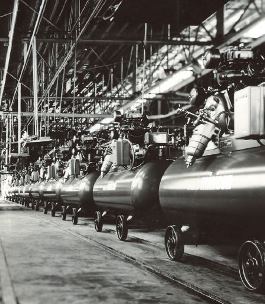 Product line for air compressor
Product line for air compressor
At the beginning of 1965, our country tumbled into a recession, which would be called the 1940 recession (stock market slump) later. Many corporations in our industry went bankrupt because of the slumping economy. Iwata Air Compressor Mfg. Co., Ltd. had to tighten its management policy and promote the streamlining. The biggest issue was to integrate the production facilities dispersed between two factories - Tsunashima Factories No.1 and No.2. It was expected that, by integrating all the facilities into Factory No.2, the company would be able to reduce management cost and inventory and promote environmental
measures. The construction work for the integration started in August 1965, and the movement
of equipment from Factory No.1 began in February the following year and finished in November of the same year. At the new factory site, a separate building was constructed for every product category (spray guns, air compressors, coating facilities, etc.) to boost productivity for each of these products significantly. Also, the company built a "general technology center" to enable more advanced research and development activities.
In order to conduct sales activities more aggressively, Iwata Air Compressor Mfg. Co., Ltd. absorbed two firms in the Kansai and Kyushu regions - Iwata Coating Equipment Corporation (Osaka City) and Kyushu Iwata Coating Equipment Corporation (Kita-Kyushu City) - both established jointly with Umei Industry Co., Ltd. The two firms became Osaka Branch in October 1966 and Kyushu Sales Office in April 1968, respectively. Kyushu Sales Office
was relocated to Fukuoka City in August of the same year, and its name was changed to Fukuoka Sales Office. Setting up these two branches brought about huge effects not only in
cutting on commissions but also in boosting sales and improving after-sales service.
Entry into the medium-sized air compressor market
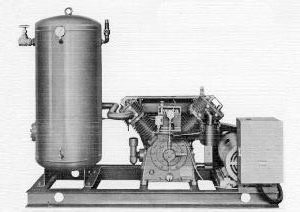 MCB-15
MCB-15
As industrialization progressed, the trend of air compressor demand began to change in the mid-1960s. While compact air compressors had been most popular until then, demand for medium-sized air compressors with larger capacity was growing. Iwata Air Compressor Mfg. Co., Ltd. started the development of medium-sized air compressors around 1965. In the mediumsized air compressor market, however, there was fierce competition, with pioneering major manufacturers in dominant positions. So they laid out a development strategy based on the results of intensive marketing researches, including those conducted abroad, with the focus on air-cooled models. For the development, the company purchased a piece of land next to Yokohama Factory and completed the construction of a factory dedicated to mediumsized air compressors in 1968. This factory was put into full-scale operation in the fall of 1969, launching mass production.
Foray into overseas markets

By the mid-1960s, Iwata Air Compressor Mfg. Co., Ltd. had started to ship its products to 20 countries in the world. Particularly, its spray guns were well received in Taiwan, and its small-sized air compressors in Thailand. With the company completely tied up meeting the demand of the domestic market, however, the foray into overseas markets remained an issue to be considered. At the time, the most appealing market for the company was Europe. In 1965, they exported wider spray guns to European nations, such as Finland, Sweden and Denmark, where very positive market feedback was gained. Moreover, the popularity of these guns provided a foothold for marketing in Belgium and the Netherlands as well. Based on these circumstances, the company came to the conclusion that it should open a resident office in
Europe to establish a sales network. In October 1968, a local subsidiary called Europe Iwata was established in The Hague of the Netherlands (Den Haag). Two employees were dispatched to this subsidiary and started to market coating equipment and air compressors. After dealership agreements were signed with 10 local dealers and actual sales activities began, however, problems surfaced that could not be identified through the marketing researches. As in Japan, coating jobs were unpopular because they were considered difficult, dirty and dangerous (a situation that is referred to as the "3K problem" in Japan). The quality of
workers engaged in these jobs was extremely low, and coating equipment was handled poorly. Unfortunately, Iwata Air Compressor Mfg. Co., Ltd. was focusing on the development of medium-sized air compressors at the time, which consequently derailed its effort to develop products that would suit the needs of the European markets, stalling the local sales activities. In July 1969, Europe Iwata was closed down. This attempt to do business in Europe, however, gave the company a deep understanding of the markets there and allowed it to acquire local dealerships. These provided vital experiences that would form the foundation for future overseas expansion. Twenty years later, the experiences paid off in
a big way.
Construction of a new coating equipment factory
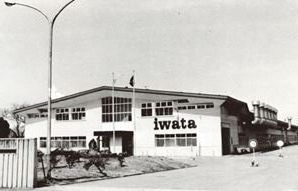 Appearance of Tohoku Iwata’s factory
Appearance of Tohoku Iwata’s factory
As the land surrounding Yokohama Factory was designated as an urbanization control area in 1969, Iwata Air Compressor Mfg. Co., Ltd. began a nationwide research to find a site for a factory dedicated to coating equipment and air compressors besides Yokohama Factory in anticipation of a future increase in demand. From several candidate sites, the company chose the premises of Fujiki Junior High School located in Omagari City (now Daisen City) of Akita
Prefecture that was planned to be closed down. They decided to construct a coating equipment factory there. In October 1972, the new factory was established as Tohoku Iwata Coating Equipment Co., Ltd. (later renamed Akita Iwata Coating Equipment Co., Ltd.; now Akita Factory of the Coating Division) with a capital of 50 million yen. Ever since, the factory has continued steady growth not only to become a central site for the production of our spray guns but to function as the technical backbone for spray gun production overseas.
New management team to get through a recession
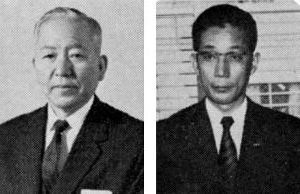 Left: Sukezo Iwata of Chairman / Right: Kazuya Iwata of President
Left: Sukezo Iwata of Chairman / Right: Kazuya Iwata of President
On May 29, 1973, Iwata Air Compressor Mfg. Co., Ltd. carried out a management shakeup, including the change of the president. Sukezo Iwata, who had headed the company in place of the first president, Hatsutaro Iwata, since 1965, stepped down to serve as the chairman, and Kazuya Iwata, the then senior managing director, became the new president. As the new president took office, the company announced a three-year management plan, its first ever.
The economic environment surrounding the new management team was not very favorable, however. On the contrary, the company was facing a lifeand-death crisis when they got started. In October 1973, the first oil shock hit
our country's economy overheated due to the so-called Japanese archipelago
remodeling plan. The coating equipment market shrank substantially, and the
company experienced runaway inflation.
The drastic organizational reform was intended to respond to these
changes. The first thing that was done was to shift several departments,
mainly R&D and production departments, to a divisional structure consisting
of the coating equipment division and air compressor division, thus allowing
the company to meet market needs for specific products quickly. Secondly,
the company made the production engineering department an independent
organization so that it could handle all kinds of product. Around 1973, the
economic landscape grew even darker, sending Japan into a period of low
growth from the high-growth period that had lasted for many years, and the
nation's economy found itself in difficult times.
In order to rev up its business performance, which had started to falter, Iwata Air Compressor Mfg. Co., Ltd. took a series of measures such as
relocating excess labor to support sales and reducing personnel. In fact, the
company did everything it could. It was through these frantic blood-sweating
efforts that IWATA survived the nightmarish 1975-1976 period during which
company after company went bankrupt.
The five years after the oil shock were a time of trial and endurance.
Launch of Fukushima Iwata
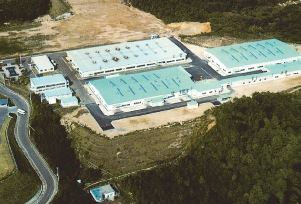 Fukushima Iwata
Fukushima Iwata
While making all-out efforts to get over the recession, Iwata Air
Compressor Mfg. Co., Ltd. was also accelerating the establishment of three
domestic factories to prepare for the future need to increase production.
In particular, the relocation of the air compressor machining and assembly
departments, which occupied the majority of the floor space of Yokohama
Factory, was seen as the key to a future increase in production. Of the several
candidate sites, one met all the site conditions - availability of industrial water,
electric power and labor and the convenience of logistics - which was Yabuki
Town in Shirakawa County, Fukushima Prefecture.
In September, 1975, Fukushima Iwata Coating Equipment Co., Ltd. (now
Fukushima Factory of the Air Energy Division) was founded with a capital
of 80 million yen. Fukushima Factory, where small-sized air compressor were
manufactured, was furnished with NC lathes, machining centers and other
state-of-the-art facilities including the latest automated production lines in
order to survive cutthroat price competition.
The capital of the factory was increased to 300 million yen in 1978, and the
second phase of construction work began in April 1981. As the construction
of production facilities (air tanks, coating lines and assembly lines) was
completed, Fukushima Factory was put into full-scale operation as a smallsized
air compressor factory in October. With a production capacity of 3,000
units per month, the factory first produced the N series small-sized air
compressors and then the P series.
Introduction of factory automation (FA)
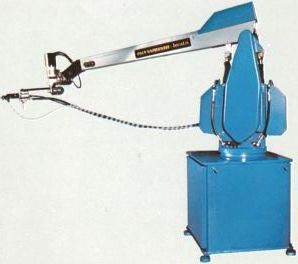 AR-62 coating robot (hydraulic type)
AR-62 coating robot (hydraulic type)
One problem that plagued our nation's industrial sector at the time was
shortages of human resources resulting from workers avoiding so-called "3K"
jobs. Coating jobs were also seen as "3K," and it was imperative for Iwata Air
Compressor Mfg. Co., Ltd. to introduce factory automation (FA).
To address this situation, IWATA formed a business alliance with
Mitsubishi Heavy Industries, Ltd. and jointly developed Japan's first coating
robot "AR-62." In August 1975, the company brought to market this new
robot, which earned a good reputation not just in Japan but abroad as well.
In 1980, IWATA launched the "AR-63," the world's first coating robot
equipped with a microcomputer-based data processor. This was followed
by the MRP series released in 1982, which was the first microcomputercontrolled
coating robot in the world. In 1985, the company unveiled the
MRP-400 series, the world's first electric direct teaching robot. The coating
robots developed by IWATA gained high acclaim because, when combined
with facilities such as conveyors and driers, they enabled the provision of
comprehensive solutions to customer needs for automated coating. Since
then, these robots have been improved continuously as the foundation for the
expansion of the company's coating facility business.